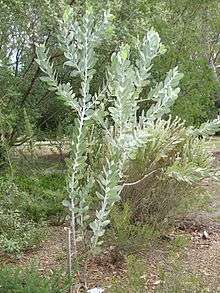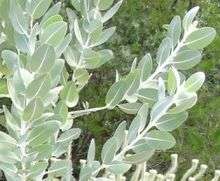Eucalyptus pleurocarpa
| Mealy gum, Tallerack | |
|---|---|
 | |
| Eucalyptus pleurocarpa, juvenile | |
| Scientific classification | |
| Kingdom: | Plantae |
| Clade: | Angiosperms |
| Clade: | Eudicots |
| Clade: | Rosids |
| Order: | Myrtales |
| Family: | Myrtaceae |
| Genus: | Eucalyptus |
| Species: | E. pleurocarpa |
| Binomial name | |
| Eucalyptus pleurocarpa | |
| E. pleurocarpa, field distribution | |
_(20165942804).jpg)

Eucalyptus pleurocarpa, commonly known as either mealy gum, silver marlock, white marlock, white-leaved marlock, blue mallee or tallerack[1] is a mallee eucalypt that is native to Western Australia.
Description
The mallee typically rows to a height of 2 to 5 metres (7 to 16 ft)[2] and a width of 3 to 6 metres (10 to 20 ft)[3] and has smooth bark. It has a spreading to erect and straggly habit with many thin stems rising from a lignotuber.[4]
The thick and leathery foliage is a pale blue grey colour and quite waxy.[5]
The buds, fruits and stems are white and waxy. The crown of this species is composed completely of juvenile leaves arranged oppositely. The glaucous leaf blade elliptical in shape with a length of 16 centimetres (6.3 in) and a width of 8 cm (3.1 in).
The buds and fruits are arranged in groups of three and have four teeth-like sepals on the rim of the bud's base.[1] The flowers are white with stamens in four bundles and appear in mid-summer. The ribbed fruit is a four-sided, almost cubic shape.
This mallee is easily recognised in the field by its form, large, white, waxy leaves and, when in flower, stamens clustered in four groups.[6]
Taxonomy
It was originally named Eucalyptus tetragona[7] by the botanist Robert Brown in 1814 as part of Matthew Flinders work General remarks, geographical and systematical, on the Botany of Terra Australis. A Voyage to Terra Australis. It was later reclassified by Johannes Conrad Schauer in 1844 as part of Johann Georg Christian Lehmann's work Myrtaceae. Plantae Preissianae. Other synonyms include; Eucalyptus × tetragona as described by Ferdinand von Mueller in 1864 and Eucalyptus eyreana as described by L.A.S.Johnson & K.D.Hill in 2007.[8]
The species name for the plant pleurocarpa is from the Greek words pleura meaning rib and carpos meaning fruit - because of the ribbed fruits.[4]
The species belongs to the sub-genus Eudesmia which all have the stamens in four bundles each at the corner of the square-shaped flower. The sub-group also includes E. erythrocorys[4]
Distribution
Like most mallees, the tree is well suited to arid and semi-arid environments.[5]
E. pleurocarpa is found at two different locations on the undulating sandplains of south-western Western Australia from Eneabba in the Wheatbelt region in the north and between Albany and Esperance in the Great Southern and Goldfields-Esperance regions to the south.[9]
It grows in grey to white sandy soils, often also containing gravel. It is emergent and conspicuous in shrubby heath-land communities. Associated eucalypt species include E. decipiens, E. falcata, E. hebetifolia, E. incrassata, E. thamnoides, E. uncinata and E. wandoo.[1]
Cultivation
The plant is sold commercially as an ornamental plant and the flowers and foliage are used as cut flowers. It is drought tolerant but is susceptible to frost and can grow in a range of soils in a full sun position.[3]
The species grows quickly recovers quickly following bushfire, re-sprouting prolifically from the lignotuber and usually flowering in its third year.[1]
See also
References
- 1 2 3 4 "Eucalyptus pleurocarpa - blue mallee, tallerack" (PDF). Eucalypts of Western Austrlia. Retrieved 22 October 2017.
- ↑ "Eucalyptus pleurocarpa". FloraBase. Western Australian Government Department of Parks and Wildlife.
- 1 2 "Eucalyptus pleurocarpa - Tallerack". Plant Selector. Retrieved 22 October 2017.
- 1 2 3 "Eucalyptus pleurocarpa". Australian Native Plants Society. Retrieved 22 October 2017.
- 1 2 "Fact Sheet: Mallee Trees". Gardening Australia. Australian Broadcasting Corporation. 26 October 2017.
- ↑ Brooker, I. & Kleinig, D., Eucalyptus, An illustrated guide to identification, Reed Books, Melbourne, 1996
- ↑ page 29 of Chippendale, G. M. (George McCartney); Australia. Forestry and Timber Bureau (1973), Eucalypts of the Western Australian goldfields : (and adjacent wheatbelt), Australian Government Publishing Service for the Minister for Primary Industry, ISBN 978-0-642-00064-4
- ↑ "Eucalyptus pleurocarpa Schauer". Atlas of Living Australia. Global Biodiversity Information Facility. Retrieved 22 October 2017.
- ↑ "Distribution of E. pleurocarpa - noting distribution is in two areas".